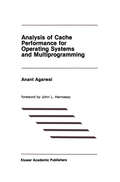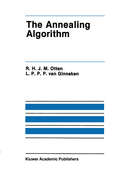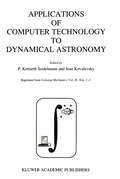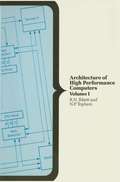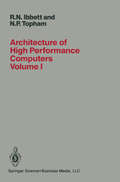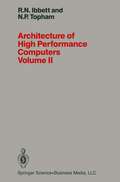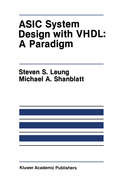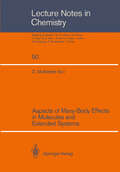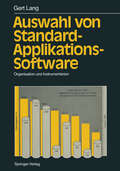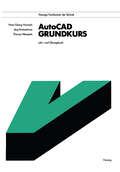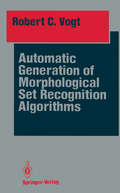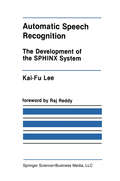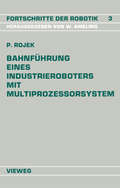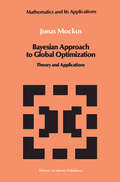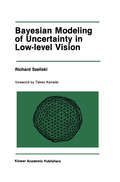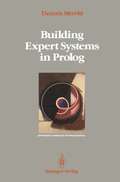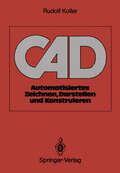- Table View
- List View
Analysis of Cache Performance for Operating Systems and Multiprogramming (The Springer International Series in Engineering and Computer Science #69)
by AgarwalAs we continue to build faster and fast. er computers, their performance is be coming increasingly dependent on the memory hierarchy. Both the clock speed of the machine and its throughput per clock depend heavily on the memory hierarchy. The time to complet. e a cache acce88 is oft. en the factor that det. er mines the cycle time. The effectiveness of the hierarchy in keeping the average cost of a reference down has a major impact on how close the sustained per formance is to the peak performance. Small changes in the performance of the memory hierarchy cause large changes in overall system performance. The strong growth of ruse machines, whose performance is more tightly coupled to the memory hierarchy, has created increasing demand for high performance memory systems. This trend is likely to accelerate: the improvements in main memory performance will be small compared to the improvements in processor performance. This difference will lead to an increasing gap between prOCe880r cycle time and main memory acce. time. This gap must be closed by improving the memory hierarchy. Computer architects have attacked this gap by designing machines with cache sizes an order of magnitude larger than those appearing five years ago. Microproce880r-based RISe systems now have caches that rival the size of those in mainframes and supercomputers.
The Annealing Algorithm (The Springer International Series in Engineering and Computer Science #72)
by R.H.J.M. Otten L.P.P.P. van GinnekenThe goal of the research out of which this monograph grew, was to make annealing as much as possible a general purpose optimization routine. At first glance this may seem a straight-forward task, for the formulation of its concept suggests applicability to any combinatorial optimization problem. All that is needed to run annealing on such a problem is a unique representation for each configuration, a procedure for measuring its quality, and a neighbor relation. Much more is needed however for obtaining acceptable results consistently in a reasonably short time. It is even doubtful whether the problem can be formulated such that annealing becomes an adequate approach for all instances of an optimization problem. Questions such as what is the best formulation for a given instance, and how should the process be controlled, have to be answered. Although much progress has been made in the years after the introduction of the concept into the field of combinatorial optimization in 1981, some important questions still do not have a definitive answer. In this book the reader will find the foundations of annealing in a self-contained and consistent presentation. Although the physical analogue from which the con cept emanated is mentioned in the first chapter, all theory is developed within the framework of markov chains. To achieve a high degree of instance independence adaptive strategies are introduced.
APL Programs for the Mathematics Classroom
by Norman D. ThomsonThe idea for this book grew out of proposals at the APL86 con ference in Manchester which led to the initiation of the I-APL (International APL) project, and through it to the availability of an interpreter which would bring the advantages of APL within the means of vast numbers of school children and their teachers. The motivation is that once school teachers have glimpsed the possibilities, there will be a place for an "ideas" book of short programs which will enable useful algorithms to be brought rapidly into classroom use, and perhaps even to be written and developed in front of the class. A scan of the contents will show how the conciseness of APL makes it possible to address a huge range of topics in a small number of pages. There is naturally a degree of idiosyncrasy in the choice of topics - the selection I have made reflects algo rithms which have either proved useful in real work, or which have caught my imagination as candidates for demonstrating the value of APL as a mathematical notation. Where appropriate, notes on the programs are intended to show the naturalness with which APL deals with the mathematics concerned, and to estab lish that APL is not, as is often supposed, an unreadable lan guage written in a bizarre character set.
APL2: Ein erster Einblick (Informationstechnik und Datenverarbeitung)
by James A. Brown Sandra Pakin Raymond P. PolivkaDieses Buch ist eine Einführung in APL2, eine Erweiterung und Verallgemeinerung der Programmiersprache APL. APL2 ist eine ideale Programmiersprache zur Lösung kommerzieller, technischer und wissenschaftlicher Probleme in einer interaktiven Rechnerumgebung. Dieses Buch konzentriert sich auf die Datenstrukturen und Programmiertechniken, die zur Lösung derartiger Probleme erforderlich sind. Es wird gezeigt, wie man APL2 zur Verwaltung von Daten, zur Modellierung von Rechnerarchitekturen, zur Beschreibung komplexer Zusammenhänge und zur Lösung von Gleichungen einsetzen kann. APL2 - Ein erster Einblick stellt APL2 vor und dokumentiert seine herausragenden Eigenschaften (insbesondere die Verwendung geschachtelter Strukturgrößen und definierter Operatoren). Das Buch ist in acht Kapitel aufgeteilt; jedes enthält zahlreiche Beispiele, mit denen der behandelte Stoff veranschaulicht wird. Zusätzlich enthält jedes Kapitel Übungsaufgaben, die der Leser zur Vertiefung und Festigung des Gelernten durcharbeiten sollte. Gleichgültig, ob Sie ein Neuling oder ein erfahrener Programmierer sind, Sie werden die besondere Akzentuierung der Darstellung der Sprache und ihrer Anwendung schätzen lernen. Dieses Buch ist eine solide Grundlage für einen guten Programmierstil in APL2.
APL2-Handbuch (Informationstechnik und Datenverarbeitung)
by Hans LochnerDas APL2-Handbuch ist ein einführendes Nachschlagewerk für die Programmiersprache APL2, wie sie von IBM für PC/DOS, VM/CMS und MVS/TSO angeboten wird. Entsprechend wird auf eine vollständige Beschreibung der Sprache (Daten, Elementarfunktionen und -operatoren), der Editoren zur Definition eigener Funktionen und Operatoren, sowie der Systemfunktionen und -variablen Wert gelegt. Darüber hinaus wird eine Auswahl der wichtigsten Fehler- und Systemnachrichten sowie Systemanweisungen geboten, und zwar in ihrer deutschen Form. Das Buch wendet sich in erster Linie an Programmierer mit APL-Vorkenntnissen, insbesondere an APL2-Praktiker, die Antworten auf spezielle Fragen oder für bestimmte Grenzsituationen suchen. Dem entspricht die systematische Gliederung des Werkes mit seinen zahlreichen Tabellen. Für mathematisch interessierte Leser ohne APL-Kenntnisse oder für Leser mit Kenntnissen in anderen Programmiersprachen bietet das APL2-Handbuch auch eine Einführung in APL2. Für diesen Zweck wird eine APL2-Beispielsitzung kommentiert. Grundsätzlich gibt der Autor zu jedem Thema eine Einführung, der sich die eigentliche Darstellung anschließt, die jeweils mit vielen Beispielen versehen ist.
Applications of Computer Technology to Dynamical Astronomy: Proceedings of the 109th Colloquium of the International Astronomical Union, held in Gaithersburg, Maryland, 27–29 July 1988
by P. Kenneth Seidelmann Jean KovalevskyProceedings of the 109th Colloquium of the International Astronomical Union, held in Gaithersburg, Maryland, 27-29 July, 1988
Applications of Human Performance Models to System Design (Defense Research Series #2)
by Grant R. McMillan David Beevis Eduardo SalasThe human factors profession is currently attempting to take a more proactive role in the design of man-machine systems than has been character istic of its past. Realizing that human engineering contributions are needed well before the experimental evaluation of prototypes or operational systems, there is a concerted effort to develop tools that predict how humans will interact with proposed designs. This volume provides an over view of one category of such tools: mathematical models of human performance. It represents a collection of invited papers from a 1988 NATO Workshop. The Workshop was conceived and organized by NATO Research Study Group 9 (RSG.9) on "Modelling of Human Operator Behaviour in Weapon Systems". It represented the culmination of over five years of effort, and was attended by 139 persons from Europe, Canada, and the United States. RSG.9 was established in 1982 by Panel 8 of the Defence Research Group to accomplish the following objectives: * Determine the utility and state of the art of human performance modelling. * Encourage international research and the exchange of ideas. * Foster the practical application of modelling research. * Provide a bridge between the models and approaches adopted by engineers and behavioral scientists. * Present the findings in an international symposium.
Applied Control of Manipulation Robots: Analysis, Synthesis and Exercises
by Miomir Vukobratovic Dragan StokicThe first book of the new, textbook series, entitled Applied Dynamics of Manipulation Robots: Modelling, Analysis and Examples, by M. Vukobratovic, published by Springer-Verlag (1989) was devoted to the problems of dynamic models and dynamic analysis of robots. The present book, the second in the series, is concerned with the problems of the robot control. In conceiving this textbook, several dillemas arouse. The main issue was the question on what should be incorporated in a textbook on such a complex subject. Namely, the robot control comprises a wide range of topics related to various aspects of robotics, starting from the syn thesis of the lowest, executive, control level, through the synthesis of trajectories (which is mainly related to kinematic models of robots) and various algorithms for solving the problem of task and robot moti on planning (including the solving of the problems by the methods of artificial intelligence) to the aspects of processing the data obtai ned from sensors. The robot control is closely related to the robot pro gramming (i. e. the development of highly-specialized programming lan guages for robot programming). Besides, numerous aspects of the con trol realization should be included here. It is obvious that all these aspects of control cannot be treated in detail in the frame of a text book.
Applied Dynamics of Manipulation Robots: Modelling, Analysis and Examples
by Miomir VukobratovicDuring the period 1982-1985, six books of the series: Scientific Fun damentals of Robotics were published by Springer-Verlag. In chronolo gical order these were: Dynamics of Manipulation Robots: Theory and Application, by M. Vukobra tovic and V. Potkonjak, Control of Manipulation Robots: Theory and Ap plication, by M. vukobratovic and D. Stokic, Kinematics and Trajectory Synthesis of Manipulation Robots, by M. Vukobratovic and H. Kircanski, Real-Time Dynamics of Hanipulation Robots by M. Vukobratovic and N. Kircanski, Non-Adaptive and Adaptive Control of Manipulation Robots, by M. Vukobratovic, D. Stokic and N. Kircanski and Computer-Aided De sign and Applied Dynamics of Manipulation Robots, by M. Vukobratovic and V. Potkonjak. Within the series, during 1989, two monographs dealing with new sub jects will be published. So far, amongst the published monographs, Vol. 1 has been translated into Japanese, Volumes 2 and 5 into Russian, and Volumes 1-6 will appear in Chinese and Hungarian. In the author's opinion, the afore mentioned monographs, in principle, cover with sufficient breadth, the topics devoted to the design of ro bots and their control systems, at the level of post-graduate study in robotics. However, if this material was also to apply to the study of robotics at under-graduate level, it would have to be modified so as to obtain the character of a textbook. With this in mind, it must be noted that the subject matter contained in the text cannot be simpli fied but can only be elaborated in more detail.
Approximative Public-Key-Kryptosysteme (Informatik-Fachberichte #206)
by Patrick Horster Hartmut IsselhorstIn der vorliegenden Arbeit werden die Einsatzmöglichkeiten approximativer Verfahren für Public-Key-Kryptosysteme untersucht. Dazu werden in einer allgemeinverständlichen Einleitung die notwendigen Grundlagen erarbeitet. Im Anschluß daran werden Resultate über eine reellwertige Approximation periodischer und nichtperiodischer Funktionen für Verschlüsselungssysteme mit öffentlichem Schlüssel entwickelt. Weiterhin werden die kryptologischen Eigenschaften rationaler Zahlen untersucht. Diese fließen in die Entwicklung eines neuen Konzeptes für ein Public-Key-Kryptosystem ein, die Public-Key-Hill-Chiffre, die auch digitale Unterschriften zuläßt. Zur Abrundung der Thematik werden weitere Anwendungen in verwandten Gebieten dargestellt: die exakte Arithmetik mit rationalen Zahlen auf der Basis von Gleitkommazahlen und ein neuer Ansatz für Faktorisierungsalgorithmen. Damit ist das zentrale Ergebnis die Benutzung rationaler Zahlen in Public-Key-Kryptosystemen, die eine neue Forschungsrichtung innerhalb der Kryptologie eröffnen könnte. Der fachkundige Leser erhält Informationen über neue Forschungsansätze und Methoden in der Kryptologie, fachfremde Leser erhalten einen guten Überblick über die Problemstellung der Entwicklung neuer Public-Key-Kryptosysteme.
Architecture of High Performance Computers: Volume I: Uniprocessors and Vector Processors (Computer Science Series)
by Roland N. Ibbett Nigel P. TophamThis second edition is presented as two volumes. Subtitled Uniprocessors and Vector Processors, Volume I is a revised and expanded version of the first edition; it deals mainly with the techniques used in uniprocessor architectures to attain high performance.
Architecture of High Performance Computers (pdf): Volume I Uniprocessors and vector processors
by R. IbbettArchitecture of High Performance Computers Volume II (pdf): Array processors and multiprocessor systems
by R. IbbettASIC System Design with VHDL: A Paradigm (The Springer International Series in Engineering and Computer Science #75)
by Steven S. Leung Michael A. ShanblattBeginning in the mid 1980's, VLSI technology had begun to advance in two directions. Pushing the limit of integration, ULSI (Ultra Large Scale Integration) represents the frontier of the semiconductor processing technology in the campaign to conquer the submicron realm. The application of ULSI, however, is at present largely confined in the area of memory designs, and as such, its impact on traditional, microprocessor-based system design is modest. If advancement in this direction is merely a natural extrapolation from the previous integration generations, then the rise of ASIC (Application-Specific Integrated Circuit) is an unequivocal signal that a directional change in the discipline of system design is in effect. In contrast to ULSI, ASIC employs only well proven technology, and hence is usually at least one generation behind the most advanced processing technology. In spite of this apparent disadvantage, ASIC has become the mainstream of VLSI design and the technology base of numerous entrepreneurial opportunities ranging from PC clones to supercomputers. Unlike ULSI whose complexity can be hidden inside a memory chip or a standard component and thus can be accommodated by traditional system design methods, ASIC requires system designers to master a much larger body of knowledge spanning from processing technology and circuit techniques to architecture principles and algorithm characteristics. Integrating knowledge in these various areas has become the precondition for integrating devices and functions into an ASIC chip in a market-oriented environment. But knowledge is of two kinds.
Aspects of Many-Body Effects in Molecules and Extended Systems: Proceedings of the Workshop-Cum-Symposium Held in Calcutta, February 1–10, 1988 (Lecture Notes in Chemistry #50)
by Debashis MukherjeeThis volume features invited lectures presented in the workshop-cum-symposium on aspects of many-body effects in molecules and extended systems, Calcutta, February 1 - 10, 1988. The organizers invited leading experts to present recent developments of many-body methods as applied to molecules and condensed systems. The panorama portrayed is quite broad, but by no means exhaustive. The emphasis is undoubtedly on a "molecular point of view".
Auswahl von Standard-Applikations-Software: Organisation und Instrumentarien
by Gert LangDas vorliegende Buch ist ein Wegweiser zur Auswahl von Standard-Applikations-Software. Ausgehend von ersten Überlegungen zum Einsatz von Standard-Software bis zur konkreten Entscheidung für ein Standard-Software-Produkt, erhält der Leser für alle Phasen dieses Auswahl- und Entscheidungsprozesses wichtige Orientierungshilfen, konkrete Werkzeuge und praktische Fallbeispiele an die Hand. Die vorgestellten Werkzeuge, wie z.B. die "Standardstrukturpläne", wurden in einem komplexen Projekt zur Software-Auswahl in einem Großunternehmen des Maschinen- bzw. Fahrzeugbaus entwickelt, da geeignete Instrumentarien für diese Aufgabe bisher nicht am Markt verfügbar sind. Die Lektüre des Fachbuches bringt für das Management das notwendige Verständnis für die Problematik eines solchen Projektes und für die mit der Durchführung des Projektes Beauftragten das Rüstzeug für eine konsequente wirtschaftliche und reproduzierbare Software-Auswahl. Die Software-Auswahl wird nicht als isolierte Aufgabe beschrieben, sondern eingebettet in den Rahmen Informationslogistik/CIM/Organisationsentwicklung; das Buch ist deshalb auch für Beratungsunternehmen, Software-Häuser und betriebswirtschaftliche Praktiker sowie Studenten interessant.
Automatic Generation of Morphological Set Recognition Algorithms (Springer Series in Perception Engineering)
by Robert C. VogtSince the early days of computers, machine learning and automatic programming have attracted researchers in computer science and related fields, particularly pattern recognition and automatic control theory. Most of the learning concepts in machine perception have been inspired by pattern recognition approaches that rely on statistical techniques. These statistical techniques have applicability in limited recognition tasks. Automatic programming in perception systems has generally been limited to interfaces that allow easy specification of the task using natural language. Clearly, machine learning and automatic programming can make percep tion systems powerful and easy to use. Vogt's book addresses both these tasks in the context of machine vision. He uses morphological operations to implement his approach which was developed for solving the figure-ground problem in images. His system selects the correct se quence of operators to accept or reject pixels for fmding objects in an image. The sequence of operators is selected after a user specifies what the correct objects are. On the surface it may appear that the problem solved by the system is not very interesting, however, the contribution ofVogt' s work should not be judged by the images that the system can segment. Its real contribution is in demonstrat ing, possibly for'the frrst time, that automatic programming is possible in computer vision systems. The selection of morphological operators demonstrates that to implement an automatic programming-based approach, operators whose behavior is clearly defined in the image space are required.
Automatic Speech Recognition: The Development of the SPHINX System (The Springer International Series in Engineering and Computer Science #62)
by Kai-Fu LeeSpeech Recognition has a long history of being one of the difficult problems in Artificial Intelligence and Computer Science. As one goes from problem solving tasks such as puzzles and chess to perceptual tasks such as speech and vision, the problem characteristics change dramatically: knowledge poor to knowledge rich; low data rates to high data rates; slow response time (minutes to hours) to instantaneous response time. These characteristics taken together increase the computational complexity of the problem by several orders of magnitude. Further, speech provides a challenging task domain which embodies many of the requirements of intelligent behavior: operate in real time; exploit vast amounts of knowledge, tolerate errorful, unexpected unknown input; use symbols and abstractions; communicate in natural language and learn from the environment. Voice input to computers offers a number of advantages. It provides a natural, fast, hands free, eyes free, location free input medium. However, there are many as yet unsolved problems that prevent routine use of speech as an input device by non-experts. These include cost, real time response, speaker independence, robustness to variations such as noise, microphone, speech rate and loudness, and the ability to handle non-grammatical speech. Satisfactory solutions to each of these problems can be expected within the next decade. Recognition of unrestricted spontaneous continuous speech appears unsolvable at present. However, by the addition of simple constraints, such as clarification dialog to resolve ambiguity, we believe it will be possible to develop systems capable of accepting very large vocabulary continuous speechdictation.
Bahnführung Eines Industrieroboters mit Multiprozessorsystem (Fortschritte der Robotik)
by Peter RojekBayesian Approach to Global Optimization: Theory and Applications (Mathematics and its Applications #37)
by Jonas MockusBayesian Modeling of Uncertainty in Low-Level Vision (The Springer International Series in Engineering and Computer Science #79)
by Richard SzeliskiVision has to deal with uncertainty. The sensors are noisy, the prior knowledge is uncertain or inaccurate, and the problems of recovering scene information from images are often ill-posed or underconstrained. This research monograph, which is based on Richard Szeliski's Ph.D. dissertation at Carnegie Mellon University, presents a Bayesian model for representing and processing uncertainty in low level vision. Recently, probabilistic models have been proposed and used in vision. Sze liski's method has a few distinguishing features that make this monograph im portant and attractive. First, he presents a systematic Bayesian probabilistic estimation framework in which we can define and compute the prior model, the sensor model, and the posterior model. Second, his method represents and computes explicitly not only the best estimates but also the level of uncertainty of those estimates using second order statistics, i.e., the variance and covariance. Third, the algorithms developed are computationally tractable for dense fields, such as depth maps constructed from stereo or range finder data, rather than just sparse data sets. Finally, Szeliski demonstrates successful applications of the method to several real world problems, including the generation of fractal surfaces, motion estimation without correspondence using sparse range data, and incremental depth from motion.
Building Expert Systems in Prolog (Springer Compass International)
by Dennis MerrittWhen I compare the books on expert systems in my library with the production expert systems I know of, I note that there are few good books on building expert systems in Prolog. Of course, the set of actual production systems is a little small for a valid statistical sample, at least at the time and place of this writing - here in Gennany, and in the first days of 1989. But there are at least some systems I have seen running in real life commercial and industrial environments, and not only at trade shows. I can observe the most impressive one in my immediate neighborhood. It is installed in the Telephone Shop of the Gennan Federal PTT near the Munich National Theater, and helps configure telephone systems and small PBXs for mostly private customers. It has a neat, graphical interface, and constructs and prices an individual telephone installation interactively before the very eyes of the customer. The hidden features of the system are even more impressive. It is part of an expert system network with a distributed knowledge base that will grow to about 150 installations in every Telephone Shop throughout Gennany. Each of them can be updated individually overnight via Teletex to present special offers or to adapt the selection process to the hardware supplies currently available at the local ware houses.
